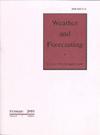Statistical predictability of Euro-Mediterranean subseasonal anomalies: The TeWA approach
IF 3
3区 地球科学
Q2 METEOROLOGY & ATMOSPHERIC SCIENCES
引用次数: 0
Abstract
It is widely known from energy balances that global oceans play a fundamental role in atmospheric seasonal anomalies via coupling mechanisms. However, numerical weather prediction models still have limitations in long-term forecasting due to their nonlinear sensitivity to initial deep oceanic conditions. As the Mediterranean climate has highly unpredictable seasonal variability, we designed a complementary method by supposing that (1) delayed teleconnection patterns provide information about ocean–atmosphere coupling on subseasonal timescales through the lens of (2) partially predictable quasi-periodic oscillations, since (3) forecast signals can be extracted by smoothing noise in a continuous lead-time horizon. To validate these hypotheses, subseasonal predictability of temperature and precipitation was analyzed at 11 reference stations in the Mediterranean area in the 1993–2021 period. The novel method, presented here, consists of combining lag-correlated teleconnections (15 indices) with self-predictability techniques of residual quasi-oscillation based on Wavelet (cyclic) and ARIMA (linear) analyses. The prediction skill of this Teleconnection-Wavelet-ARIMA (TeWA) combination was cross-validated and compared to that of the SEAS5-ECMWF model (3 months ahead). Results show that the proposed TeWA approach improves the predictability of first-month temperature and precipitation anomalies by 50–70% compared with the forecast of SEAS5. On a moving-averaged daily scale, the optimum prediction window is 30 days for temperature and 16 days for precipitation. The predictable ranges are consistent with atmospheric bridges in teleconnection patterns (e.g., ULMO) and are reflected by spatial correlation with SST. Our results suggest that combinations of the TeWA approach and numerical models could boost new research lines in subseasonal-to-seasonal forecasting.欧洲-地中海副季节性异常的统计可预测性:TeWA 方法
根据能量平衡,人们普遍知道全球海洋通过耦合机制在大气季节性异常中发挥着重要作用。然而,由于数值天气预报模式对初始深海条件的非线性敏感性,其在长期预报方面仍然存在局限性。由于地中海气候具有高度不可预测的季节变异性,我们设计了一种补充方法,假设(1)延迟远缘模式通过(2)部分可预测的准周期振荡的透镜,提供亚季节时间尺度上海洋-大气耦合的信息,因为(3)预报信号可以通过平滑连续前沿时间范围内的噪声来提取。为了验证这些假设,对 1993-2021 年期间地中海地区 11 个基准站的气温和降水的次季节可预测性进行了分析。本文介绍的新方法包括将滞后相关的远程连接(15 个指数)与基于小波(周期)和 ARIMA(线性)分析的残差准振荡自预测技术相结合。这种远程连接-小波-ARIMA(TeWA)组合的预测技能经过交叉验证,并与 SEAS5-ECMWF 模型(提前 3 个月)的预测技能进行了比较。结果表明,与 SEAS5 预测相比,建议的 TeWA 方法可将首月气温和降水异常的可预测性提高 50-70%。在移动平均日尺度上,温度的最佳预测窗口为 30 天,降水的最佳预测窗口为 16 天。可预测的范围与远缘模式中的大气桥(如 ULMO)一致,并反映在与 SST 的空间相关性上。我们的研究结果表明,TeWA 方法与数值模式的结合可以推动亚季节到季节预报的新研究方向。
本文章由计算机程序翻译,如有差异,请以英文原文为准。
求助全文
约1分钟内获得全文
求助全文
来源期刊

Weather and Forecasting
地学-气象与大气科学
CiteScore
5.20
自引率
17.20%
发文量
131
审稿时长
6-12 weeks
期刊介绍:
Weather and Forecasting (WAF) (ISSN: 0882-8156; eISSN: 1520-0434) publishes research that is relevant to operational forecasting. This includes papers on significant weather events, forecasting techniques, forecast verification, model parameterizations, data assimilation, model ensembles, statistical postprocessing techniques, the transfer of research results to the forecasting community, and the societal use and value of forecasts. The scope of WAF includes research relevant to forecast lead times ranging from short-term “nowcasts” through seasonal time scales out to approximately two years.
 求助内容:
求助内容: 应助结果提醒方式:
应助结果提醒方式:


